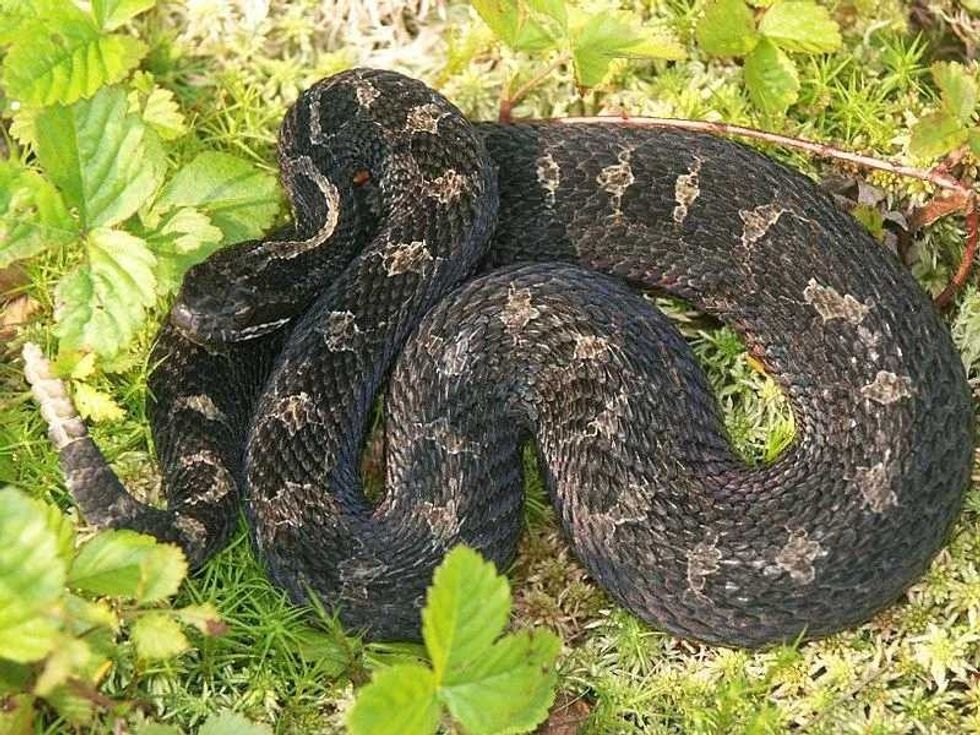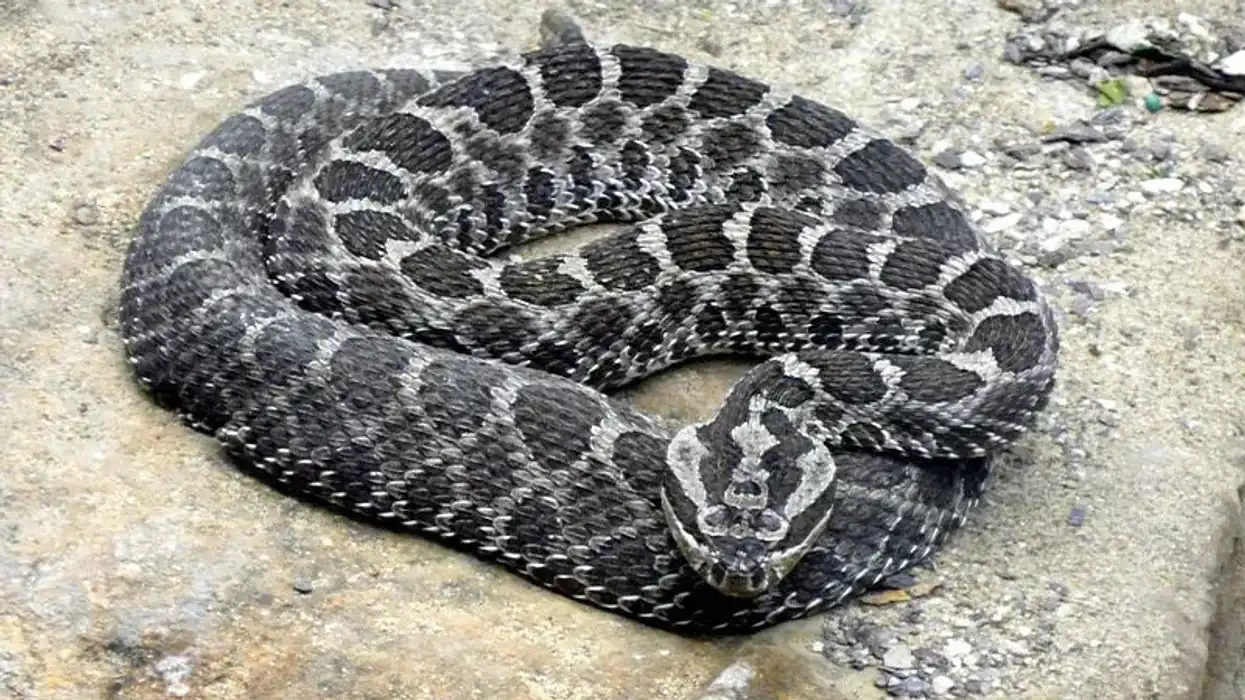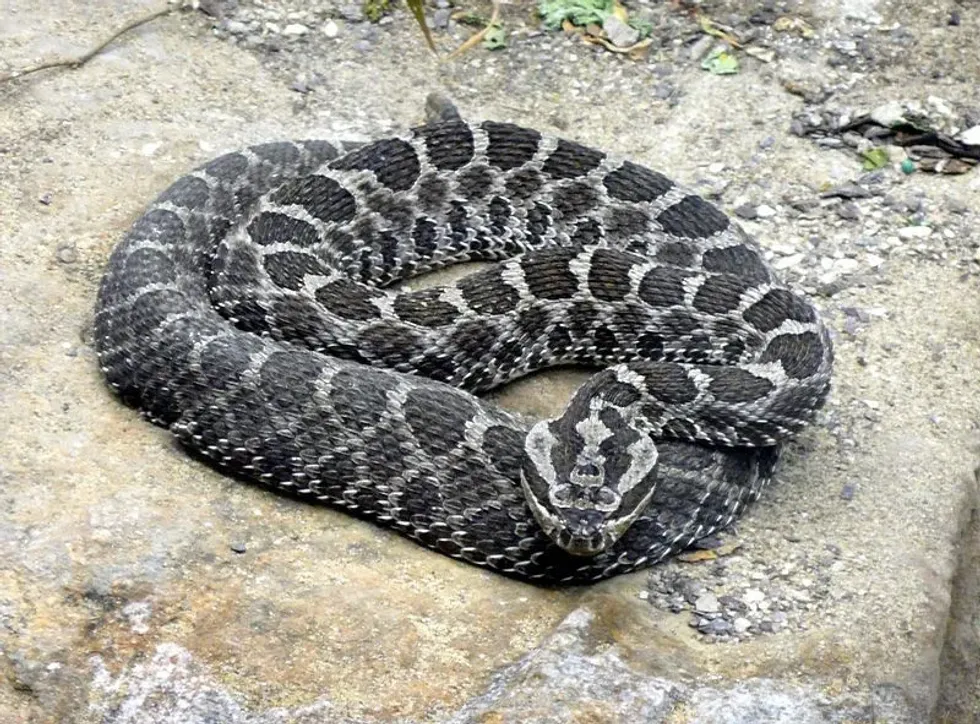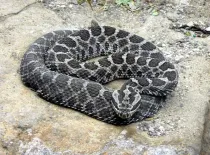Fun Massasauga Facts For Kids

Are you curious to learn about a fascinating venomous yet non-aggressive rattlesnake species? We bring you the Massasaugas, a pit viper that camouflages itself to remain hidden in its environment. Massasaugas have three subspecies to them.
Massasaugas subspecies are found in gray, black, or brown shades, and they have patterns of gray or brown stripes along their body length. Massasaugas are oviparous and give birth to offsprings.
The average litter consists of 5-20 young ones. The Eastern Massasauga rattlesnake, Sistrurus catenatus, is an endangered species threatened by habitat loss. They are classified as Endangered species in many US states, including Michigan, Missouri, and Wisconsin.
Their habitat range extends to the Nearctic regions. They inhabit the wetlands and grasslands. They prey on small mammals and other animals like lizards, snakes, insects, and other such creatures. They prefer temperate climates and are highly terrestrial animals.
If you are more enthusiastic about discovering many more reptile friends, then check out our content on the black rat snake and gopher.
Massasauga Interesting Facts
What type of animal is a Massasauga?
The Massasaugas are a species of rattlesnakes that is venomous. There are three subspecies: Eastern Massasauga, Desert Massasauga, and Western Massasauga. They are pit vipers having a heat-sensing organ between the nostril and the eyes on either side of its head.
What class of animal does a Massasauga belong to?
Massasauga Rattlesnake belongs to the class Reptilia. The distinct features of the reptiles include vertebrates, having ectothermic or cold-blooded bodies, and having scales.
How many Massasaugas are there in the world?
Although there is no comprehensive study done on the world population of these threatened or endangered species of reptiles, there is an independent study from the Federal Register of the US Government on the Population count of Eastern Massasauga.
The study done in 2016 found 558 Eastern Massasaugas in the habitats, including parts of New York, Wisconsin, Illinois, Ontario, to name a few. Out of these 558 snakes, 263 snakes are known to be thriving, and 211 are most probably to be extirpated, and 84 snakes do not have any traces.
The study clearly showed a steady decline in the population of these threatened and endangered species of animals.
Where does a Massasauga live?
These rattlesnake species are primarily found in the swamps, wetlands, and grasslands. Massasauga Rattlesnake range starts from North America, Canada and spreads to Mexico. Massasaugas are found in Illinois, New York, Indiana, Iowa, Minnesota, Michigan, Ohio, Pennsylvania, Ontario, and Wisconsin. The Massasauga Rattlesnake (Michigan State's natural inhabitant) is the deadliest snake found in Michigan and Ontario.
What is a Massasauga's habitat?
The Massasaugas are native to temperate climate habitats. During early fall to the end of spring, these snakes are predominantly seen in habitats like the wetlands of prairies, swamps, bogs, and meadows.
During spring and summer, they shift habitats base to drier lands or upland areas like farm fields and grasslands. They are found in upland areas up to an elevation of 1500 m.
Who does Massasauga live with?
The Eastern Massasauga rattlesnake is passive and prefers solitude. During hibernation, the Eastern Massasauga may be found solitary or in smaller groups. These rattlesnakes species prefer to hibernate close to water sources in the wetlands. Their home range is minimal. These snake species are active from April to the end of fall.
How long does a Massasauga live?
The Eastern Massasauga rattlesnake (Sistrurus catenatus) is known to live up to 20 years in captivity. There is no evidence of their lifespan measured in the wild.
How do they reproduce?
The breeding season for the Eastern Massasaugas is spring and fall. The female discards her old skin and releases pheromones to attract the male for mating. The Massasaugas are oviparous.
The gestation period of the Massasaugas is around 3.5 months, where the females bear the young ones inside their bodies. Massasaugas give live birth to 5-20 neonates.
They use abandoned burrows of mammals or fallen logs in their habitat to deliver the young ones. Their mothers protect the neonates for a short period after they become independent. The females give birth every year.
What is their conservation status?
As per the IUCN Red List categorization, the Massasaugas have been listed under the Least Concern category. The extensive distribution of their habitat and the large population in these regions keeps them on the Least Concern list.
However, the Eastern Massasauga (Sistrurus catenatus) is listed as an endangered species in the States of Illinois, Indiana, Pennsylvania, Iowa, Missouri, Minnesota, New York, Ohio, and Wisconsin. Michigan classifies the Eastern Massasaugas in the 'special concern' zone.
Ontario's Endangered Species Act, 2007, places Eastern Massasauga in the threatened category. Rapid urbanization and land degradation due to pollution have led to habitat loss and a decline in population for this Eastern Massasauga.
Massasauga Fun Facts
What do Massasaugas look like?
They belong to the pit vipers group. The Eastern Massasauga have hollow fangs in the front of their mouth. They are medium-sized rattlesnakes with heterothermic bodies, i.e.
their body temperatures vary according to the region in their habitat. Their midbody region is covered with 25 rows of keeled scales, and their triangular head contains nine enlarged scales.
They are found in shades of black, gray, brown, or a mix of both gray and brown. These reptiles depict sexual dimorphism meaning there is a clear distinction between male and female. The Massasauga's have rattles at the end of their bodies which helps to warn their enemies.

How cute are they?
These meek and pliant creatures, with their camouflaging skin, make a unique appearance for the beholders. The younger rattlers are sure to capture your hearts with a cute button for the rattle at the end of their tail.
How do they communicate?
These snake species are diurnal; their active hours are spent daily around their habitat range. The Eastern Massasauga rattlesnake uses chemical and physical signs to communicate with others of their kind, especially during breeding time. The rattlesnakes' bodies are highly adapted to pick up their habitat surroundings' slightest vibrations.
Their pit organs or the heat-sensing organs help them detect warm-blooded prey near them. These snakes use rattling of tails as a signal to show aggression and threaten their predators or attackers. When they sense danger, they generally coil up and strike.
How big is a Massasauga?
The Massasaugas can grow up to 30 inches in size. The Massasauga rattlesnakes are almost half the size of a Fox snake that can grow up to 54 inches. In these species of rattlesnakes, the males are larger than the females.
How fast can a Massasauga move?
The Eastern Massasauga is known to be slow and docile snakes. They primarily depend on a rectilinear motion for movement, which inhibits speed.
Although there are no known sources to document the Massasauga's speed in its natural habitat, it is inferred that the rattlesnakes may travel up to a speed of 2-3 mph. Humans can beat the rattlesnakes by speed any day, as humans can run an average of 28 mph.
How much does a Massasauga weigh?
The Massasaugas are smaller snakes compared to other pit vipers like Lachesis snakes. The Lachesis snakes weigh enormous at up to 176 oz, whereas the Massasauga weighs 15 oz.
What are their male and female names of the species?
There is no specific terminology to refer to the males and females Massasauga. They are called male Massasauga or female Massasauga.
What would you call a baby Massasauga?
The young rattlesnakes are called rattlers. In general, the young snakes are called snakelets.
The newly born young ones are termed neonates, and the newly hatched ones are called hatchlings. The young Massauga are born up to 9 in long and weigh below one ounce. The young ones are born with a single button at the end of the tail from where their rattle develops.
What do they eat?
They eat smaller mammals like rodents, lizards, shrews, and insects. They are also known to savor small birds, frogs, and other snakes around their habitat. The younger rattlers are more aggressive eaters and can attract prey by rattling their tails. The Eastern Massasaugas attack their prey, wait for it to die completely, and then gobble up their food.
The Massasauga Rattlesnake (Sistrurus catenatus) is predated by milk snakes, hawks, raccoons, and foxes in its habitat range.
Are they aggressive?
The Eastern Massasauga is a non-aggressive rattlesnake. They use camouflage in their habitat to remain obscure and generally freeze when approached by a threat. They would make the rattling sound with their tails to signal their attacker's warning. They only strike when they feel threatened further.
Their small fangs do not run deeper on their attacker's body; hence humans with clothing will only feel a brush off from the snake bite. The snake bite would only cause swelling or irritation at the bite site.
There have been only a couple of incidents in history where people died of Massasauga bite, owing to delay in getting the anti-venom dotes.
Would they make a good pet?
They will make an excellent pet to those who have sufficient knowledge of rearing rattlesnakes. The Massasaugas need plenty of space and a closed enclosure to ensure the safety of others around. Hence caring for a Massasauga at home may not seem to be a plausible option to everyone.
Did you know...
This endangered Eastern Massasauga rattlesnake is susceptible to fungal infections on its scales, which may prove fatal to them.
The Massasauga snake returns to the same hibernation area every year in their habitat.
Crayfish or mammal burrows are the favorite hibernation site for these rattlesnakes.
Rattle segments of these species of rattlesnakes help determine the snake's age. For example, if there are seven rattle segments, these snakes may be more than seven years of age.
The venom shot by a young rattler is more deadly as they cannot control the venom injected in their bite.
How to pronounce Massasauga?
The syllabic pronunciation of Massasauga is 'mas-uh-saw-guh.' This native American word in the Ojibwe language translates as 'great river-mouth.'
How deadly is the Massasauga rattlesnake?
Though the Massasauga is venomous, their bites are painful and life-threatening only if proper medical attention is not given in time. The venom of a rattlesnake is cytotoxic, meaning it destroys the tissues and prevents blood clotting.
They only subdue their prey and partially digest them with the action of biting with venom. They are not deadly to humans as they keep away from any human's vicinity for their own good.
Here at Kidadl, we have carefully created lots of interesting family-friendly animal facts for everyone to discover! Learn more about some other reptiles including corn snake, or rattlesnakes.
You can even occupy yourself at home by drawing one on our Massasauga coloring pages.
We Want Your Photos!
More for You
Bachelor of Arts specializing in English Literature

Akinwalere OlaleyeBachelor of Arts specializing in English Literature
As a highly motivated, detail-oriented, and energetic individual, Olaleye's expertise lies in administrative and management operations. With extensive knowledge as an Editor and Communications Analyst, Olaleye excels in editing, writing, and media relations. Her commitment to upholding professional ethics and driving organizational growth sets her apart. She has a bachelor's degree in English Literature from the University of Benin, Edo State.
Bachelor of Science specializing in Computer Science

Chandan ShuklaBachelor of Science specializing in Computer Science
With a Bachelor's degree in Computer Science from Aryabhatta College, University of Delhi, Chandan is a skilled and passionate technophile. He has completed a machine learning training program and is adept in various programming languages. He has been working as a content writer for two years while also striving to become a proficient tech professional.
Disclaimer
1) Kidadl is independent and to make our service free to you the reader we are supported by advertising. We hope you love our recommendations for products and services! What we suggest is selected independently by the Kidadl team. If you purchase using the Buy Now button we may earn a small commission. This does not influence our choices. Prices are correct and items are available at the time the article was published but we cannot guarantee that on the time of reading. Please note that Kidadl is a participant in the Amazon Services LLC Associates Program, an affiliate advertising program designed to provide a means for sites to earn advertising fees by advertising and linking to Amazon. We also link to other websites, but are not responsible for their content.
2) At Kidadl, we strive to recommend the very best activities and events. We will always aim to give you accurate information at the date of publication - however, information does change, so it’s important you do your own research, double-check and make the decision that is right for your family. We recognise that not all activities and ideas are appropriate for all children and families or in all circumstances. Our recommended activities are based on age but these are a guide. We recommend that these ideas are used as inspiration, that ideas are undertaken with appropriate adult supervision, and that each adult uses their own discretion and knowledge of their children to consider the safety and suitability. Kidadl cannot accept liability for the execution of these ideas, and parental supervision is advised at all times, as safety is paramount. Anyone using the information provided by Kidadl does so at their own risk and we can not accept liability if things go wrong.
3) Because we are an educational resource, we have quotes and facts about a range of historical and modern figures. We do not endorse the actions of or rhetoric of all the people included in these collections, but we think they are important for growing minds to learn about under the guidance of parents or guardians.







